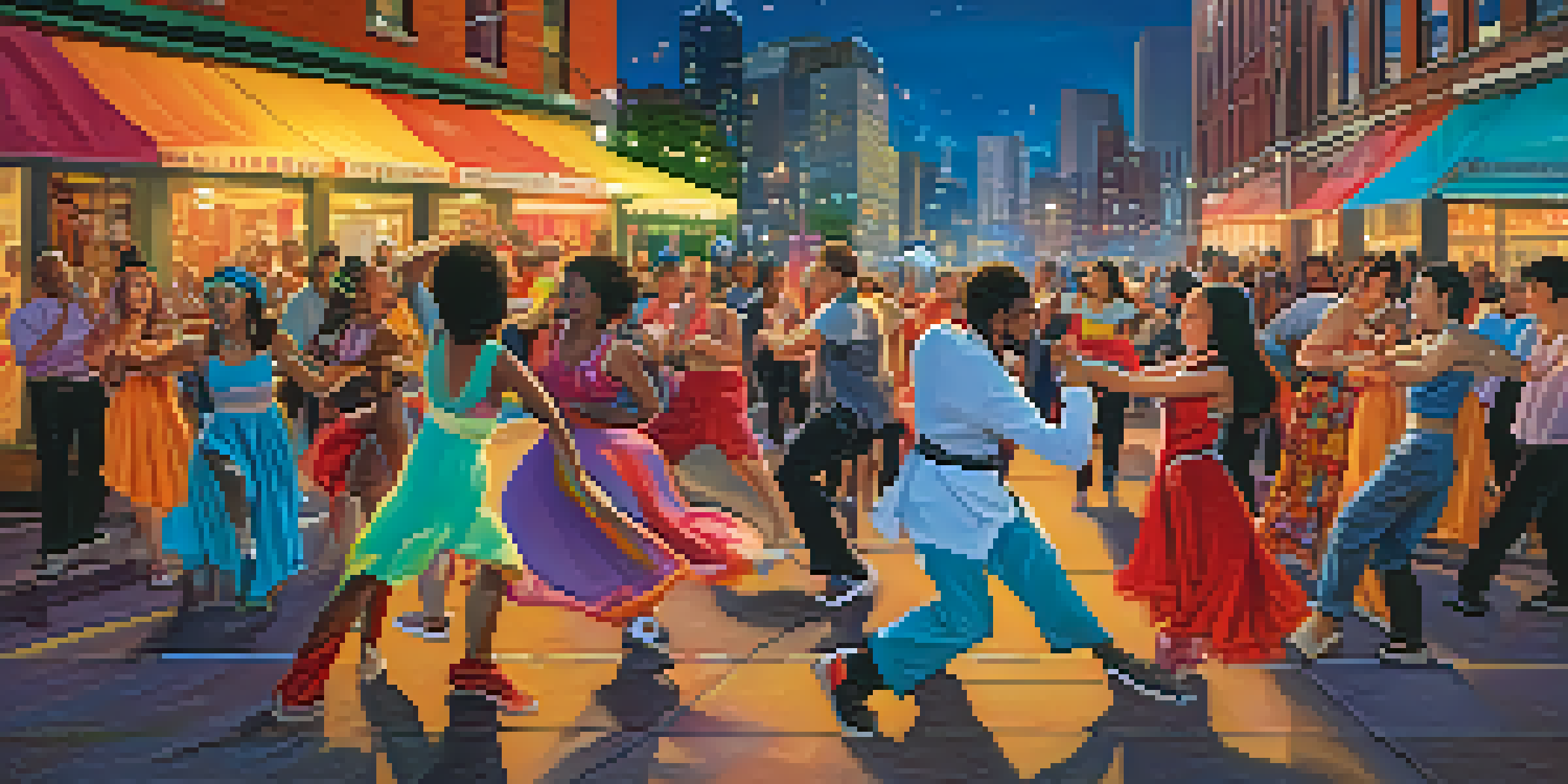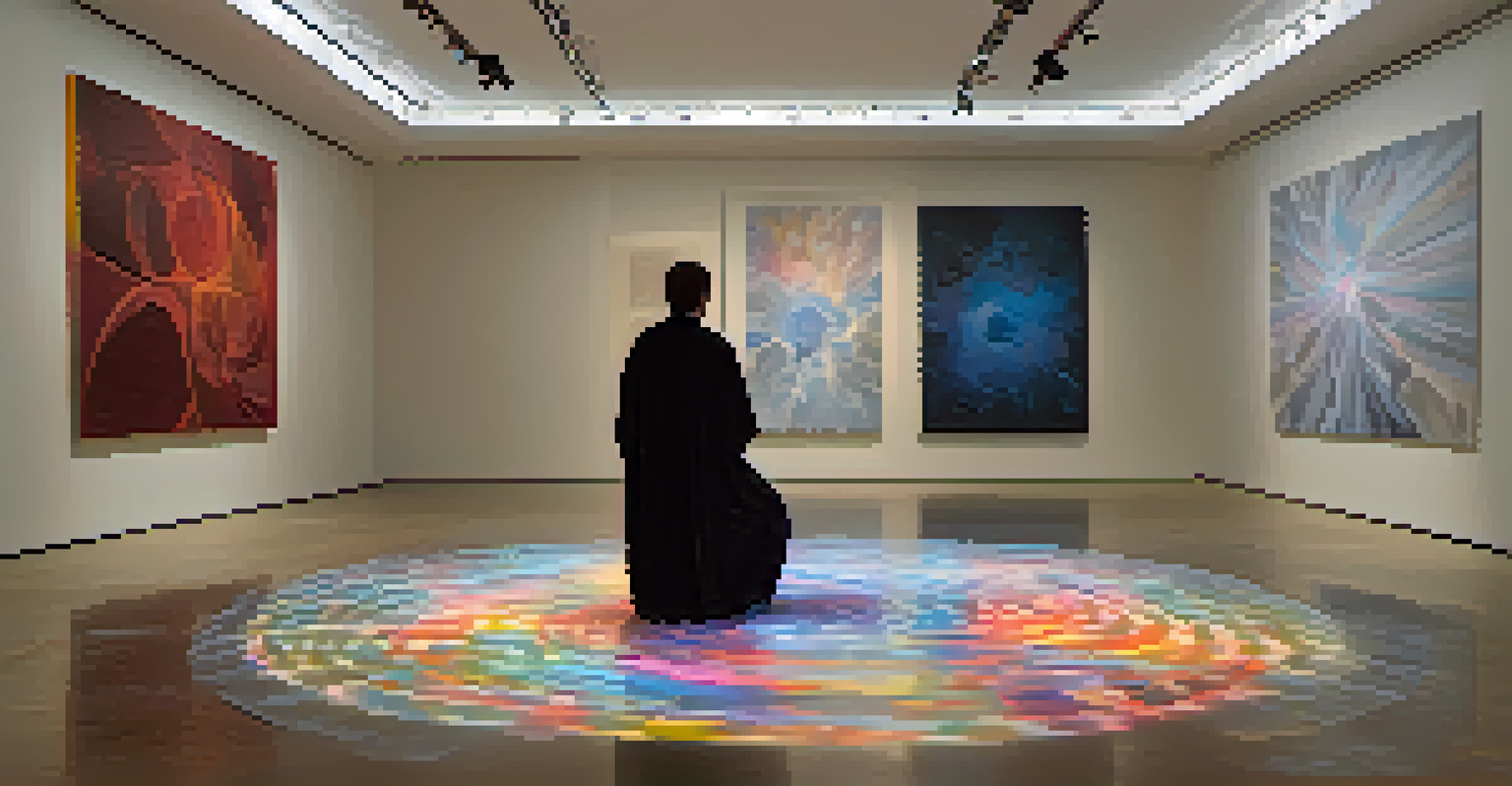The Evolution of Performance Art: From Ritual to Modern Day

Understanding Performance Art: A Brief Overview
Performance art is a captivating blend of visual art and live action, often challenging traditional boundaries. It encompasses various forms, including theater, dance, and music, to convey complex ideas and emotions. Unlike conventional art forms, performance art is ephemeral, existing only in the moment it is presented.
Performance art is a way of expressing the inexpressible.
This unique art form has roots in ancient rituals and ceremonies, where storytelling and communal experiences played a significant role. Artists use their bodies and environments as mediums to explore societal issues, personal narratives, and cultural expressions. This approach invites audiences to engage with the performance on a deeper level.
As we delve into its evolution, we'll uncover how performance art has transformed from sacred rituals to a dynamic medium for contemporary expression. Each phase of this evolution reflects shifts in societal values, technological advancements, and artistic exploration.
The Roots of Performance Art in Ancient Rituals
Performance art's origins can be traced back to ancient rituals, where storytelling and symbolic acts were integral to cultural practices. These rituals often involved music, dance, and dramatic reenactments that conveyed collective beliefs and values. They served not only as entertainment but also as a way to connect communities and honor their histories.

For example, many Indigenous cultures employed performance in rituals to connect with the spiritual realm, celebrating life events and seasonal changes. These performances were deeply rooted in their cultural identities, imbuing them with significance and purpose. The physical embodiment of stories and traditions helped preserve these cultures through generations.
Performance Art's Rich History
Rooted in ancient rituals, performance art has evolved to blend storytelling with live action, reflecting societal changes over time.
As societies evolved, the sacred nature of these rituals began to blend with artistic expression, laying the groundwork for what we now recognize as performance art. This transformation marked the beginning of a journey that would continue to adapt and redefine itself over centuries.
The Influence of Theatre and Dance on Performance Art
As performance art developed, it drew heavily from the worlds of theatre and dance, incorporating their techniques and styles. Theatrical elements such as script, character, and stage direction began to merge with more improvisational and spontaneous forms of expression. This fusion created a vibrant landscape where artists could explore a wide range of narratives and themes.
Art must be an integral part of human life, and it must be a part of the social and political context.
Dance, too, played a crucial role in shaping performance art, allowing artists to communicate emotions and ideas through movement. From ballet to modern dance, the exploration of the body as a vehicle for expression became a defining characteristic of the genre. This emphasis on physicality opened up new avenues for storytelling and connection with audiences.
The interplay between these art forms enriched performance art, enabling it to tackle complex issues such as identity, politics, and societal norms. It became a platform for artists to challenge conventions and provoke thought, making it an essential component of contemporary artistic expression.
The Avant-Garde Movement and Performance Art's Rise
The early 20th century saw the emergence of the avant-garde movement, which significantly influenced the evolution of performance art. Artists began to experiment with unconventional techniques, challenging societal norms and pushing boundaries. This era marked a shift towards more radical forms of expression, where the distinction between artist and audience became blurred.
Avant-garde pioneers like Dadaists and Surrealists used performance to provoke reactions and question reality. Their works often included elements of absurdity and chaos, encouraging audiences to engage with the art in unexpected ways. This rebellion against traditional forms set the stage for future generations of performance artists to explore their creative freedom.
Impact of Technology on Art
Modern performance art incorporates technology, allowing for innovative multimedia experiences that engage audiences in new ways.
As performance art gained traction, it became a vital medium for social and political commentary. Artists like Marina Abramović and Yoko Ono used their platforms to address pressing issues, drawing attention to the power of the human experience in a rapidly changing world.
The Role of Technology in Modern Performance Art
With the advent of technology, performance art has entered a new realm of possibilities, integrating digital elements into live performances. This evolution has allowed artists to experiment with multimedia, virtual reality, and live streaming, expanding their reach and impact. Technology has transformed how audiences engage with performance art, creating interactive experiences that transcend traditional boundaries.
For instance, artists can now incorporate video projections, soundscapes, and social media into their work, creating immersive environments that captivate viewers. This technological infusion has also fostered collaboration across disciplines, encouraging artists to work with scientists, engineers, and other creatives to push the envelope of what performance art can be.
As a result, performance art today is not just a live experience; it is a dynamic intersection of art, technology, and community. This evolution reflects the ever-changing landscape of contemporary society and the ways in which artists continue to adapt and innovate.
Contemporary Themes and Issues in Performance Art
In today's world, performance art serves as a powerful medium for addressing contemporary themes and societal issues. Artists are increasingly using their work to explore topics such as identity, race, gender, and climate change. This focus on relevant issues creates a dialogue between the artist and the audience, fostering awareness and encouraging social change.
For example, many performance artists draw from their personal experiences to highlight marginalized voices and challenge stereotypes. By sharing their stories, they invite the audience to reflect on their own beliefs and perceptions, creating a space for empathy and understanding. This trend emphasizes the importance of representation and diversity in the arts.
Art as a Tool for Social Change
Contemporary performance artists address pressing themes like identity and climate change, fostering dialogue and inspiring activism.
Moreover, performance art's ability to adapt to current events makes it a vital tool for activism. Artists often respond to political turmoil and social movements through their work, using their platforms to amplify voices and inspire action. This ongoing dialogue between art and society reinforces the idea that performance art is not just a reflection of the times but also a catalyst for change.
The Future of Performance Art: New Directions
As we look to the future, the evolution of performance art continues to unfold, embracing new ideas and directions. Artists are increasingly exploring the intersection of performance with other disciplines, including visual arts, literature, and even science. This cross-pollination opens up exciting possibilities for innovation and collaboration.
Additionally, the rise of virtual and augmented reality is likely to influence how performance art is created and experienced. These technologies can enhance storytelling, allowing audiences to engage with performances in immersive ways. As artists experiment with these tools, we may see a redefinition of space and presence in performance art.

Ultimately, the future of performance art is bright and full of potential. As artists push boundaries and explore new frontiers, they will continue to challenge our perceptions, provoke thought, and inspire change in an ever-evolving world.